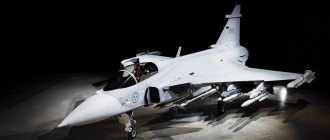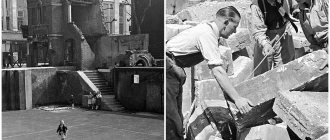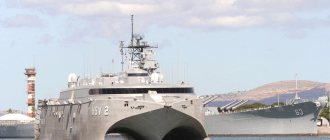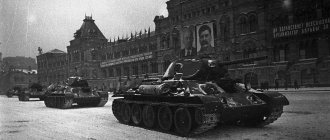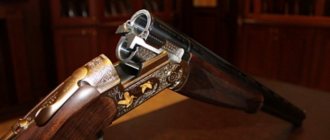SAAB 37 Viggen
5
(4)
"Duck" in Swedish
The Swedish multi-purpose aircraft Viggen (Thunder), which formed the basis of the country's Royal Air Force at the end of the last century, occupies a special place in the history of world aviation. Despite a significant number of experimental combat vehicles built using the canard aerodynamic design, almost none reached the stage of mass production. But the Swedish designers in the early 60s. considered this scheme the most successful when creating a third-generation multi-role combat aircraft, and they were not mistaken.
The SAAB-32 Lansen fighters, which were in service with the Swedish Air Force in the late 1950s, and the recently adopted SAAB-35 Draken successfully carried out their assigned tasks, but general trends in the aviation world prompted the country's military leadership that it was time to think about their successor.
Research on a promising multi-role fighter began in 1952 under the leadership of Finnish aircraft designer Arni Lakomaa, and preliminary design began in 1958. Very high demands were placed on the new car. The promising fighter was to become an element of the latest automated air defense control and guidance system STRIL 60. Its takeoff and landing characteristics were to ensure operation from specially equipped sections of highways (length 800 m, width 9 m), intended for the dispersal of aviation forces and assets during the war period (the so-called dispersed basing concept “BASE-90”). In addition, given the very small number of regular air force personnel, serious attention was paid to issues of operational manufacturability and ease of maintenance by semi-skilled personnel of reservists in the event of a full-scale deployment of troops.
In February 1961, the Air Force command approved detailed requirements for the “1500 aircraft,” and they were quite stringent. In particular, the maximum speed at altitude is at least two Machs, takeoff and landing from platforms 500 m long, preparation for a second flight in a group of 7 people (6 of them are conscripts) within 10 minutes in the fighter version, 15 minutes in the fighter version scout and 20 attack aircraft.
SAAB engineers began full-scale development of the new fighter in December 1961 after the government issued a decree on System 37. In the same year, the P&W JT8D-22 bypass turbojet was chosen as the power plant (used on passenger Boeing 727s and Douglas DC-9s), to which Swedish designers “added” an afterburner of their own design. The engine was planned to be produced under license under the designation RM8.
One of the first images of “System 37” published in the SAAB corporate newspaper. December 6, 1962
In December 1962, the Swedish Air Force command presented the appearance of System 37 to the press. Journalists were presented with a detailed description of a promising fighter with a very unusual design. Many technical solutions of Swedish engineers were truly innovative. Thrust reverse on a combat aircraft, a two-wheel main landing gear with a tandem arrangement of wheels, a modular airframe design for various aircraft variants, a PGO with a flap and a boundary layer blowing system (BLS) - all this was done for the first time in the world aircraft industry. The RM8 engine at that time was considered the most powerful “fighter” twin-circuit turbofan engine. Also, for the first time, the entire architecture of radio-electronic equipment was built around an on-board digital computer, which turned disparate systems into a targeting and navigation complex. It also included an automatic control system (ACS) and an instrument landing system (ILS) of the decimeter range.
By the beginning of 1965, the design of System 37 was completed. In April, a detailed full-size model was presented to the Air Force command and the press. The experts were presented with a very original vehicle, not only superior to its predecessors in flight-tactical characteristics and combat power, but, importantly, capable of being based in the same conditions as the Lansen and Draken. Long-term painstaking work to coordinate the relative position of the PGO and the wing made it possible to “squeeze” the maximum benefit out of the “duck” and minimize its disadvantages. And the advanced technical solutions used made the new creation of SAAB essentially an aircraft with a short take-off and landing (STOL). Air Force Commander General Lage Thunberg named the new fighter "Wiggen" ("Thunder").
In 1965, the Swedish government approved the project and decided to build six single-seat and one two-seat prototypes while preparing for mass production. At the same time, the Swedish Parliament established a special Project Directorate within the military command to monitor the progress of the project in technical and economic terms. The new division is headed by former SAAB technical director Lars Brising.
The first prototype of the Saab 37 Viggen 37-1 is presented at the Saab plant in Linköping, 1966. On the stepladder (as a makeshift podium) is Saab CEO Tryggve Holm. Photo: Flygvapenmuseums bildarkiv, license CC-BY
Construction of the first prototype began in 1964 and was completed on November 24, 1966. After numerous ground tests, on February 8, 1967, Wiggen took to the skies for the first time. The plane was piloted by the company's chief pilot Erik Dahlstrom.
Rolling out of the first prototype from the SAAB factory workshop, 1966. Photo: SAAB, license CC-BY
In parallel with flight tests, intensive ground tests continued, which revealed, in particular, the need to change the geometry of the PGO. This is what they did, starting with the second prototype, which took to the skies in September 1967. The last, sixth sample was flown in April 1969.
The first prototype 37-1 during testing, approximately 1966-67. There are no identification marks or markings. Photo: Flygvapenmuseums bildarkiv, license CC-BY
Intensive testing of prototypes revealed certain problems with the stability of the fighter on the run while turning on the reverse. Difficulties with stability and controllability in the presence of external suspensions were also revealed. However, nothing unusual, this is what tests are being carried out.
There were also flight accidents. According to the Aviation Safety Network, on May 31, 1968, the first experimental Viggen crashed. Test pilot Lennart Fyrö ejected unsuccessfully and died. Less than a year later, on May 7, 1969, the 4th prototype was lost in an accident on the ground. While testing reverse thrust, the plane flew off the runway and overturned. The pilot was not injured, but the fighter was written off as beyond repair.
The seventh prototype 37-7, built to replace the 4th prototype lost in the accident. Initially used to test the propulsion system, it was later converted into the JA37 prototype interceptor. Approximately 1974-75. Photo: Flygvapenmuseums bildarkiv, license CC-BY
Testing and development continued, and already in 1968 a contract was signed for the construction of the first batch of 175 vehicles, 150 of which were supposed to be built in the AJ37 tactical fighter version, and 25 in the SK37 two-seat combat trainer version. In addition, the program provided for the further development of reconnaissance modifications for general (SF37) and naval (SH37) reconnaissance, as well as the specialized JA37 fighter-interceptor. In general, the initial plans envisaged the construction of a fleet of 800 Wiggens, but serial production ended with the release of 329 aircraft (plus 8 prototypes).
Serial production and operation
The first production fighter-bomber AJ37 began flying on February 23, 1971, and four months later the aircraft began to enter service with the Royal Swedish Air Force, replacing the previous brainchild of SAAB - the A-32 Lansen. In total, SAAB produced 108 aircraft of this modification (serial numbers 37001 - 37108). These machines were in operation until March 2000.
True, the first serial "Wiggen" never had to serve its homeland. On September 14, 1971, at the F3 airbase in Malmslätt, the Test Department of the Swedish Military Equipment Administration filmed a demo film about the new combat aircraft. During a “short” landing (without holding), the Wiggen flew off the runway, overturned and caught fire. Fortunately, the pilot survived, but the car was written off.
Extinguishing the fire of the first production AJ37 (37 001) at Malmen airbase. 09/14/1971 Photo: Flygvapenmuseums bildarkiv, license CC-BY
At the same time, work was underway on other options. The Spark Sk37 was first flown into the sky on July 2, 1970 by test pilot Pers Pellebergs, and the production vehicle of this version entered service a year after the single-seat version.
Double SK 37 Viggen of the Test Department of the Swedish Military Equipment Directorate at Malmen Air Base, 09/10/1972. Photo: Flygvapenmuseums bildarkiv, license CC-BY
Serial combat training aircraft in the amount of 17 units (s/n 37801-37817) have been supplied to the troops since 1973. Ten of them were later converted into electronic warfare (EW) SK37E ECM aircraft. At the end of the 90s. they replaced the obsolete J 32E Lansen.
King Carl Gustaf XVI of Sweden, together with an instructor pilot, take seats in the cockpit of a two-seat SK37 from the F7 Såtenäs air wing, 1974. Photo: Flygvapenmuseums bildarkiv, license CC-BY
A second cabin for the instructor, equipped with a pair of periscopes, was equipped instead of a behind-the-cockpit fuel tank. The plane had neither radar nor sophisticated navigation equipment, so its combat capabilities were limited only to the use of unguided weapons. To increase directional stability, the keel had a 10-cm (in height) “superstructure”, which later migrated to the interceptor.
Double SK 37 Viggen of the Test Department of the Swedish Military Equipment Directorate at Malmen Air Base, 09/10/1972. Photo: Flygvapenmuseums bildarkiv, license CC-BY
The first experimental “spark” crashed on August 27, 1975 due to the destruction of the engine compressor. True, it was no longer quite a “sparka”, or rather, not a “sparka” at all. To replace the previously lost fourth prototype, the first Sk37 was replaced with a nose section that was left over from a decommissioned one. Still, it is not for nothing that there is a belief in aviation that emergency vehicles cannot be used as donors. Another confirmation of this...
Photo reconnaissance aircraft SF37 on display at the Prague Aviation Museum, 2011. Photo by the author
Having established mass production of the first two modifications, the company focused on reconnaissance aircraft. The “land” photo reconnaissance aircraft SF37 took off on May 21, 1973, and on December 10 of the same year it was followed by the naval reconnaissance and strike SH37.
SF37 reconnaissance aircraft in flight. Photo: Flygvapenmuseums bildarkiv, license CC-BY
In the period 1975-1980. The manufacturer supplied the Air Force with 27 SH37s (s/n 37901-37927), which replaced the S 32C Lansen in service. They were in service until the end of 2003.
The nose section of an SF37 at the F11 Wing Museum. Norrköping, 2016. On February 6, 1990, this aircraft (f/n F13-12) made an emergency landing after a bird strike. It was restored, after which it received a used F-21-50. Decommissioned June 30, 1998. Photo by the author
The SF37 was equipped with seven AFAs for vertical and oblique photography, all of which were located in the nose. In addition, the reconnaissance equipment included an IR linear scanning station with a data recording unit. The external hardpoints could additionally accommodate a complex reconnaissance container “Red Baron”, equipped with a strobe light for night photography, or a LOROP container with a long-focus camera SKa 24D-600 for perspective shooting. The pilot's cockpit was equipped with a special periscope so that he could see the ground directly below the aircraft during the photography phase.
Location and characteristics of cameras in the nose of the SF37. Photo from the information board at the F11 Museum. 2016 Photo by the author
The SH37 naval reconnaissance prototype was built on the basis of the third experimental Wiggen, and outwardly it was very difficult to distinguish it from the tactical fighter version. The new modification was equipped with an improved PS-371/A radar with an increased detection range and improved performance against the background of the water surface. The complex of objective control equipment included two video cameras to capture the “picture” of the radar display and record data on the target location, as well as a tape recorder to record the pilot’s comments.
The SH37 prototype (s/n 37900) was converted from the third production AJ37 (s/n 37003). The plane is captured at the Malmen base, date unknown. Photo: Flygvapenmuseums bildarkiv, license CC-BY
In the period 1977-1980. SAAB produced 28 reconnaissance and attack vehicles (s/n 37950-37977), which served until 2006. Unlike the SF37, the naval version was equipped with an on-board radar and could use almost the entire arsenal of weapons available to the base AJ37. The reconnaissance equipment of this option included: 3 AFA SKa 24C-120 for panoramic photography, a wide-angle AFA SKa 24-57, a pair of AFA SKa 31-600 for high-altitude photography, as well as a VKA702 IR scanner. For night photography, a hanging container with three SKa 34-75 AFAs was used. In addition, the naval version could use the same containerized reconnaissance assets as the SF.
Refueling an SH 37 Viggen in preparation for a second flight during an exercise in Bjørvik, 08/20/1981. Photo: Flygvapenmuseums bildarkiv, license CC-BY
In general, the start of operation of the new equipment was relatively painless. True, in 1974-75. three fighters were lost due to the destruction of the wing (the pilots survived). Moreover, in 1975 - with an interval of 4 days, on October 6 and 10. Extensive research revealed the presence of microcracks in the main wing spar, caused by an error in drilling technology. Fortunately, cracks could only occur in the side members of the first 28 production cars. Later “Wiggens” had structural elements reinforced to increase their service life. And on the first planes the spar was replaced.
If we talk about the accident rate of the 37th model as a whole, then it is difficult to call it very high. There are many examples in the history of aviation when up to 30% of built aircraft were lost during their life cycle. In the case of Wiggen, the figure is slightly higher than 12%. Taking into account experienced ones, 42 aircraft were lost in accidents and disasters, and 17 pilots were killed. At the same time, it is believed that the Wiggen was more dangerous than its predecessor SAAB-35 Draken.
All of the above options had no fundamental differences; the airframe and power plant remained identical. But the JA37 interceptor fighter, which completed the “model range,” was already significantly different from earlier versions. Increased dynamic loads forced designers to strengthen the structure of the airframe as a whole and especially the wing. Changes also affected the power plant: the RM8A engine was replaced with an RM8B turbofan engine with increased thrust by 10%, reduced smoke and improved altitude characteristics. Replacing the engine entailed lengthening the fuselage by 13 cm.
JA37 of the Swedish Air Force Historic Flight landing, Malmön, 2016. Photo by the author
The main components of the avionics complex have been almost completely updated. It included:
• pulse-Doppler radar Ericsson PS-46/A (in 1990, it received the function of simultaneous tracking of several targets), coupled with Ericsson EP-12 HUD. By the way, PS-46/A became the first European pulse-Doppler radar;
• the latest inertial navigation system KTL-70L;
• navigation Doppler radar Decca Doppler Type 72 (similar to that installed on the Anglo-French tactical fighter “Jaguar”);
• Garrett Airesearch LD-5 air signal system, similar to that installed on the American Grumman F-14 Tomcat carrier-based fighter;
• digital self-propelled gun SAAB-Honeywell SA07 – one of the first digital automatic control systems introduced into mass production;
• new state identification equipment.
The avionics complex was built around the new on-board computer Singer-Kearfott SKC-2037, produced by SAAB under license under the designation CD 107. The interceptor also received a new SAAB Mark 3 class “0-0” ejection seat.
The fighter was equipped with a built-in Oerlikon KCA 30 mm cannon with 150 rounds of ammunition.
JA37 from the F13 air wing in the parking lot. 80s Photo: https://f13.kamratforening.se, source – sv.wikipedia.org, license CC-BY
The first five AJ37 prototypes were converted into JA37 interceptor prototypes. The first of them, still with the RM8A engine, first took off from the runway on September 27, 1974. The sixth prototype was the first interceptor built from scratch. Its first flight dates back to 1975. And the first production machine, which launched the initial batch of 30 interceptors, took off on November 4, 1977 under the control of test pilot Per Pellebergs. In total, SAAB has produced 149 interceptors since 1977 (s/n 37301-37449), ending production of the Thunder with this modification in June 1990.
Flight operation of the interceptors in the Swedish air defense system began in November 1977. Moreover, the first unit reached combat readiness only at the beginning of 1981, replacing Draken aircraft on combat duty. As of 1994, 8 squadrons were equipped with JA37 interceptors.
During operation, the aircraft was continuously improved. Thus, the range of missile weapons was expanded through the integration of the Rb71 missile launcher (English medium-range air-to-air missile "Skyflash") and somewhat later (1987) - the Rb74 close-range missile launcher (American AIM-9L "Sidewinder" with all-angle homing head). In 1997, the American AIM-120 AMRAAM missile was integrated into the weapon system.
The first production JA 37 Viggen (s/n 73301), armed with a pair of Rb71 medium-range missiles, in flight. Photo: Flygvapenmuseums bildarkiv, license CC-BY
In the mid-80s. the aircraft received a modern data link from the STRIC ground guidance system, which made it possible to direct the fighter to a target without turning on its own radar. In 1986, a ground collision warning system was included in the on-board equipment. In 1987, fighter aircraft were equipped with devices for ejecting IR traps, and in 1995, devices for ejecting passive interference were added to them. Additionally, a software update in 1992 gave JA37 pilots the ability to target the gun using a heads-up display. At the same time, the self-propelled gun ensured stabilization of the aircraft in pitch and yaw, as soon as the pilot aimed the target.
Reloading the JA 37 interceptor gun from the F 13 air wing, 1981. Photo: Flygvapenmuseums bildarkiv, license СС-BY
The last stage of improvements (D) included the replacement of the on-board computer with the most modern Ericsson SAAB CD207 and a new weapon control system computer ANP-37+, a dual data bus of the MIL-STD 1553B standard, an improved navigation system and large (15x20 cm) color displays displaying the tactical situation , as well as other, less significant improvements.
Installation of the fin tip of the JA37 interceptor by the technical staff of the F13 air wing, 1982. Photo: Flygvapenmuseums bildarkiv, license СС-BY
JA37 fighters were actively used to intercept and escort aircraft approaching the Swedish borders. During the Cold War, Swedish pilots annually carried out 400-500 interceptions of various targets belonging to both the Warsaw Pact countries and the NATO bloc.
A special place was occupied by training to intercept the American reconnaissance aircraft Lockheed SR-71, which made regular flights along the western and northern borders of the USSR. Attempts to intercept “Blackbirds” flying at altitudes of more than 20 km and speeds of Mach 3 were made by Swedish pilots before, even on the Saab J-35F Draken, but for obvious reasons they were unsuccessful. But the new interceptor provided such an opportunity. Moreover, not so much by its flight characteristics, but by the most modern on-board equipment interfaced with ground guidance stations.
The first interception of an American reconnaissance aircraft was carried out by Per-Olof Eldh, now a retired colonel, who has flown more than 3,500 hours in jet fighters (from the English Electric “Lightning” to the MiG-29 and F-15). Here's how he describes the event in Paul F. Crickmore's book Lockheed Blackbird: Beyond the Covert Missions: "...As I was performing the first interception of the SR-71, the target had completed its passage of the northern part of the Soviet coastline and turned to the west, south of the Finnish island of Åland, following south of the islands of Gotland and Öland. The data link from the ground guidance station was turned on, and I took up an interception position on a collision course. From 8000 m I accelerated to Mach 1.35, then climbed very carefully, continuing to accelerate to speeds between 1.7 Mach and 2.0 M, reaching the ceiling between 18,500 and 20,000 m.
All data about the target was on my indicator... I simulated missile launches - the approach speed was very high, between 4.5M and 5M; The SR-71 was flying at a speed of 2.98M and an altitude of 21,500 m. I had visual contact. In total, I had five actual SR-71 interceptions. All can be described as successful.”
Second Life
In 1992, due to delays in the adoption of the newest Grippen fighter, the Swedish government approved a program to modernize 115 aircraft of the AJ, SH and SF modifications to the AJS 37 multi-role combat aircraft standard. The modified AJ strike aircraft received the designation AJS (48 modified vehicles), SH and SF reconnaissance aircraft - AJSH (25 aircraft) and AJSF (25 aircraft), respectively. During the process of modifications, the original plans were adjusted, and only 98 aircraft underwent modernization. And complete unification did not work out either. In particular, AJS could not use reconnaissance equipment on external hardpoints; The AJSF was still not equipped with an airborne radar.
Restored SAAB AJS37 (s/n 37074) on display at the Aerospace Museum of Spain Madrid, 2022. Photo by the author
The most “advanced” was the modified version of AJSH. It could use the entire range of AJS weapons, including the latest Rb15F anti-ship missiles and DWS 39 cluster bombs, and at the same time did not lose the ability to use suspended reconnaissance equipment.
SAAB AJSF 37 on display at the Polish Aviation Museum in Krakow, 2013. Photo by the author
In 1974 - 1975, Sweden attempted to enter the international arms market with the export version of the Viggen SAAB37X as part of the “contract of the century”, which envisaged the purchase by NATO countries of a new generation fighter to replace the F-104 Starfighter aircraft. The fight was between the American F-16, the French Mirage F-1 and the Swedish car. Despite its undeniable merits, “Wiggen” was not destined to become a “Eurofighter” for purely political reasons: Sweden pursued a policy independent of NATO, for which it “paid.” Nevertheless, foreign experts could not help but notice that the Wiggen was a serious competitor to the American, which represented the next generation of combat aircraft.
Swedish Air Force Historic Flight JA37 in flight, Malmön, 2016. Photo by the author
At the beginning of the 21st century, the Wiggens began to be gradually replaced by the new brainchild of SAAB - the Grippen multirole fighter. The last flight of the Wiggen as part of the country's Air Force took place on November 25, 2005. But even today it can often be seen at international air shows, already under the control of pilots of the Swedish Air Force Historic Flight association.
Most of the Groms were disposed of at the base in Ängelholm. The process of dismantling one aircraft lasted about a month; an interceptor took up to 6 weeks. Up to 80% of the dismantled equipment, which had a reserve in resource/service life, was returned to service and used as a repair fund.
A JA37 of the Swedish Air Force Historic Flight during post-flight training after performing at the airshow in honor of the 90th anniversary of the Royal Swedish Air Force. Malmön, 2016. Photo by the author
In general, for its time, the Wiggen was, without a doubt, an advanced aircraft, practically in no way inferior to similar machines of the great aviation powers, and in some respects even superior to them. In terms of its characteristics, it is very close to the Soviet MiG-23 and the French Mirage F.1. However, the MiG did not have a reconnaissance modification, and the “French” would hardly have been able to boast such takeoff and landing characteristics as the “Viggen”. Why the SAAB-37 did not become an export item, unlike its predecessor, the 35th model, is rather a political question. As practice shows, in “countries of developed democracies” lobbying is a sacred matter. So “Wiggen” has nothing to do with it. It may not have the French constructive elegance of the Mirages, but it is to it that I would apply the saying “well tailored, tightly sewn.” As befits a combat vehicle.
Aircraft design
The conceptual idea of the Wiggen was to unify all variants of the aircraft without making any major changes to the design. For example, reconnaissance equipment can be mounted in the avionics compartment instead of the latter. Instead of a second “asparagus” cabin, the combat aircraft houses additional equipment and a fuel tank. In addition, the characteristics of the strike modification make it possible to assign fighter missions to it, and direct support of troops to the “sparka”.
The fuselage of the aircraft has a semi-monocoque structure, and in some elements - a monocoque structure. Technologically, it is divided into the front part with the cockpit and the rear part. The fuselage of the interceptor was lengthened by 13 cm, its lower part was changed due to the installation of a built-in cannon. The main wing has a variable sweep along the leading edge. In the root sections the sweep is 45°, in the end sections – 57°. Along the trailing edge along the entire span there are two-section elevons, which are the roll and pitch controls.
The front wing has a sweep of 60°. The trailing edge of the wing is equipped with flaps along the entire span. To increase their efficiency at low speeds, a boundary layer blowing system is used, powered by the engine compressor.
The vertical tail is represented by a classic keel with a rudder driven by a hydraulic drive. To ensure that the Wiggen fits into the shelters of its predecessors, the keel is foldable.
The airframe is made of aluminum and titanium alloys and composite materials. The wing skin, elevons, flaps, rudder, as well as the brake flaps and hatches of the landing gear niches have a multi-layer structure. Many power elements are also multi-layer adhesive structures.
The aircraft landing gear is three-post. The front pillar with twin wheels having a turning mechanism are retracted forward. The main struts, equipped with two-wheel tandem bogies, are retracted into the wing. When cleaning, the shock absorber struts of the main supports are compressed by 1/3 of the stroke, and the wheels are placed in a horizontal position. The use of two-wheeled struts is due to heavy loads during landing with a steep descent without holding, which makes it possible to reduce the landing distance. The automatic thrust control also serves the same purpose, helping the pilot maintain a relatively constant speed during landing.
The canopy (canopy and folding part) is teardrop-shaped and made of solid sheets of prestressed glass. The material of the flashlight is designed to withstand the dynamic load that occurs in a collision with a bird weighing 2 kg at a speed of 1100 km/h. The ejection seat makes it possible to leave an aircraft on the ground (class 0-0).
SF37 photographic equipment and ejection seat. F11 Museum, 2016. Photo by the author
The power plant of all modifications, except the JA37, consists of a single RM8A turbofan engine. The JA37 has an upgraded RM8B engine with an improved fan and low pressure compressor. The high-pressure turbine has been modified in terms of cooling the blades, and the temperature of the gases in front of it has been increased by 55°. The gas dynamics of the afterburner have been improved, as a result of which its ignition time has been reduced by almost half with less smoke. Specific fuel consumption in afterburner decreased from 2.6 kg/kg/hour for the RM8A to 2.52 kg/kg/hour.
Jet nozzle. The upper flap of the thrust reverser is lowered. Photo by the author
Due to the new compressor, the margin of surge stability has increased, the engine has become more “loyal” to distortions of the air flow at the fan inlet, and the fuel control automation has begun to respond to overload, angle of attack and its changing trend. The weight of the RM8B with reverse device is 2350 kg. Engine life between overhauls is 600 hours. Specific fuel consumption at maximum mode is 0.64 kg/kg/hour.
The fuel on the aircraft is placed in six fuselage tanks, which, apparently, are not enough, since for the most part the Wiggen was operated with a ventral fuel tank.
The aircraft control system is hydraulic irreversible with elevons and rudder drive. The front wing flaps are interlocked with the elevons in such a way that the deflection of the latter automatically causes the deflection of the flaps to compensate for the pitching moment. The Wiggen is equipped with an automatic control system that has damping, stabilization, leveling, etc. modes. Using this system, the JA37 can be aimed at a target in director mode.
Electrical equipment compartment. F11 Museum, 2016. Photo by the author
Only the JA37 has built-in weapons. It consists of a 30-mm single-barrel Swiss KSA cannon with 150 rounds of ammunition. Compared to the Aden cannon used on the Draken and, by the way, on the same Viggen, but in suspended containers, the KSA has twice the mass of the cartridge, more than five times the effective firing range at low altitudes and almost an order of magnitude (8 times) greater than the kinetic energy of the cartridge.
And in conclusion, an absolutely wonderful video that clearly demonstrates the highest takeoff and landing characteristics of the Viggen, as well as the skill of the pilots of the Royal Swedish Air Force.
Please rate what you read on a five-point scale!
Your rating is very important (by giving a rating, you agree to the processing of your IP address)
Average rating: 5/5. Voted: 4
No ratings yet.
We're sorry you didn't like the material.
Tell me why?
see also
- Saab
Similar aircraft
- Republic F-105 Thunderchief
- McDonnell Douglas F-4 Phantom II
- Dassault Mirage F1
- Dassault Mirage 5
- IAI Kfir
- Tupolev Tu-28
- Mikoyan-Gurevich MiG-23
- Mikoyan MiG-27
- Avro Canada CF-105 Arrow
Notation sequences
- Aircraft with Saab cabin: · 21R · 29 Tunnan · 32 Lansen · 35 Draken · 37 Viggen
· 39 Gripen · NG Gripen
NAME
The car is marked with the number “93”. Saab, however, constantly advertises it as "9-3": the name is pronounced "nine three". The 9-3 was produced in 1998, and the next improved model, the 9-3, was released in 2002.
Historically, the Saab 93 (pronounced "ninety-three") was produced from 1955 to 1960.
Performance characteristics
- Modification:
AJ.37 - Wingspan, m:
10.60 - Aircraft length, m:
16.40 - Aircraft height, m:
5.90 - Wing area, m2:
52.20 - Weight, kg
- empty:
9000 - normal takeoff:
15480 - maximum takeoff:
20450 - internal fuel:
4750 - Engine type:
1 Volvo Flygmotor RM-8A turbofan - Thrust, kN
- unforced:
1 x 65.70 - forced:
1 x 115.52 - Maximum speed, km/h:
- near the ground:
1350 (M=1.1) - at altitude:
2195 (M=2.1) - Ferry range, km:
3000 - Practical range, km
- at the optimal height:
2150 - near the ground:
930 - Combat range, km:
500—1000 - Rate of climb at the ground, m/s:
192 - Practical ceiling, m:
15500 - Max. operational overload:
7.5 - Crew, persons:
1 - Armament:
No built-in cannon armament - Combat load:
5000 kg on 7 suspensions - On the central suspension:
- Container with two or one 30 mm M/55 cannon (Aden)
- For 2 ventral ones:
2 PU 6x135 NUR Bofors - On 2 internal underwings:
2 6x135 Bofors missile launchers or 2 Rb.04E (Rbs.15) anti-ship missiles or 2 Rb.05 (Rb.75) air-to-surface missiles - On 2 outer underwings:
up to 16 light bombs
References
| This article or section requires citations that appear in a reputable publication. This notice was posted on January 26, 2010. |
- ↑ Wiggen
or Wigg is also a type of duck from Sweden.
Duck
is a French word meaning "duck", but in this case there is no relation, since the name
Wiggen
has a mythological background: it is the thunder produced by Mjolnir, Thor's hammer. - Secret nuclear submarines give Sweden a security guarantee Foresight 2005, no. 1 (Swedish Military Investigation Agency)
